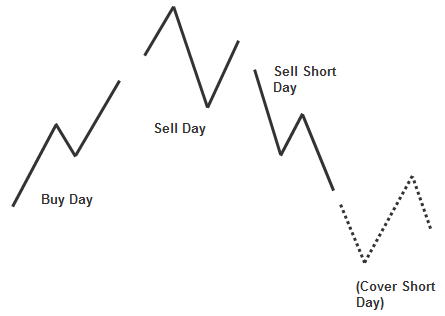I want to introduce you to an important concept today. This may not interest some of our readers because it is an extremely abstract and “fuzzy” concept—you will no doubt find great difficulty applying this with any degree of precision. However (and this is a big however), this is one of the most important concepts I know and it provides the foundation for my approach to each trading day.
In the early 1950s, George Douglas Taylor, a grain trader on the CBOT, wrote a book that is now published as The Taylor Trading Technique. Though it is worth your time to read the original, you should be forewarned that this is one of the most poorly written documents in the English language! It is an extremely difficult read. Linda Raschke has been a major advocate of Taylor’s work, and she has written several articles that are much easier to read and understand than the original book.
Taylor observed a pattern in grain and stock prices that he formalized into a system that he called the Book Method. In short, Taylor’s pattern was that the market tended to go up in a trend day, which he called the Buy Day. The next day in the cycle was the Sell Day which usually exceeded the high of the buy day, but did not follow through, and closed under the buy day’s high. On the last day of the cycle, the Sell Short day, the market trended down strongly, which set up the next buy day.
There are numerous refinements and important details to Taylor’s system, but the core ideas are the three-day rhythm, and measuring average swings in a market to get some idea of what your reasonable profit targets might be. Taylor also had a fairly convoluted set of rules for pushing the cycle back and forward to get it to fit prices better, but, in my opinion, this is a needless complication if you are using the pattern conceptually. As a further refinement, he did note that there were variations of the basic pattern. For instance, in strong trends the pattern was often two Buy Days in a row (B, B, S, SS, etc). Again, it is probably not important to catalog every variation, and is far more important to understand the underlying concept.
Based on my observations from many years of trading, Taylor’s core ideas ring true. Rather than getting lost in the details of his system, I try focus on what I believe is the driving principle: that a trend day in a market will usually be followed by a consolidation day, and, if the the trend day was strong, the extreme of the trend (high for uptrend, low for downtrend) will usually be slightly exceeded the following day. Many people will be tempted to enter with the previous trend on those days (paying above the high of a previous strong uptrend day, for instance), but that is, on balance, a losing trade. If you understand the Taylor Rhythm, you will expect consolidation the following day, rather than a followthrough trend day. Also, I tend to think of the Taylor Rhythm as more symmetrical (a four-day cycle), expecting, as a general rule that a “cover shorts” day follows a Sell Short day.
The Taylor Rhythm is simply a large-scale expression of the concept of markets alternating between trends and trading ranges. Rather than trying to apply it with strict systematic rules, I treat this as a large-scale framework, and find that it gives me a great edge in my mental game plan for each trading day.


3 Comments on “The Taylor Rhythm”
Agree that this work IS perhaps the worst example of the English language on the planet. I like your thinking and LBR DOES an adequate “translation” of the The Taylor Technique. Your description reminds me a lot of Peter Steidlmayer’s Market Profile in that there is a trend day which translates (on a Market Profile) to a vertical move on a horizontal axis and then there is stabilization of that move which translates on a Market Profile to a widening of the profile as it rotates around a price where traders temporarily find “value” and then continues on, usually from the center of that horizontal “bump” and usually in the direction from which it came. Does this make sense or do I need more meds?
If Taylor’s book is is one of the most poorly written documents in the English language then I would say Steidlmayer’s seminal Market Profile book, “Mind Over Markets” (known as MOM in the MP community) is perhaps one of the best examples of poor book editing with a book that has great content. And I say that as an ES trader who trades MP everyday and has read MOM numerous times. I’ve never read Taylor’s book.
Andrew Menaker, PhD
http://www.andrewmenaker.com
I learned of this concept from Gary Smith’s book. I like it too. It is especially useful for spotting potential tops when several days open near the highs and sell off from the open.